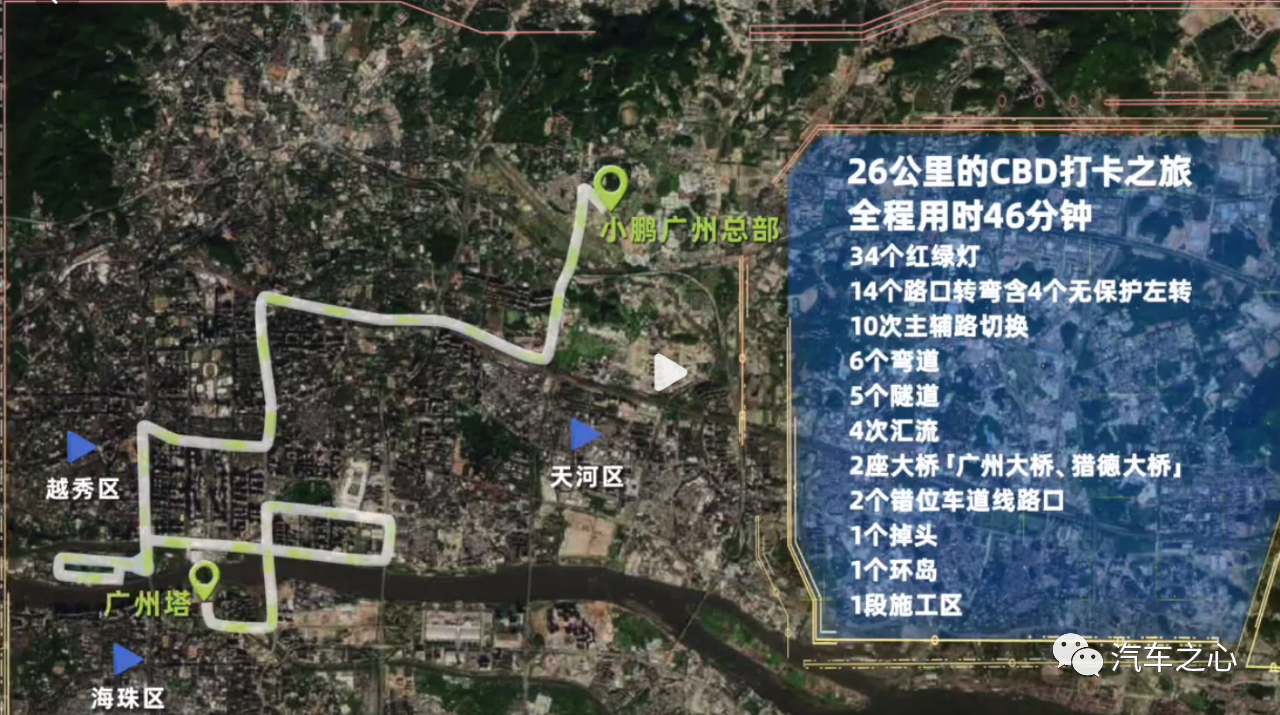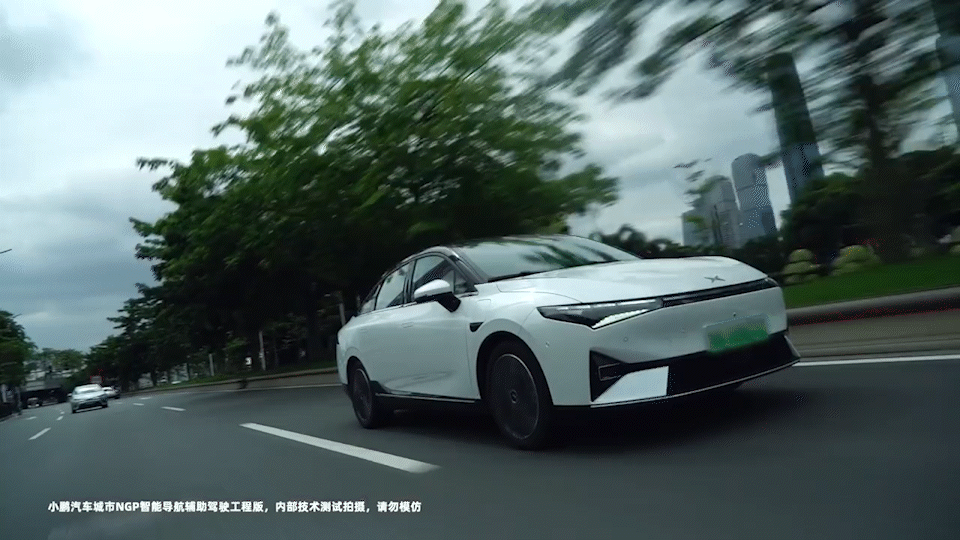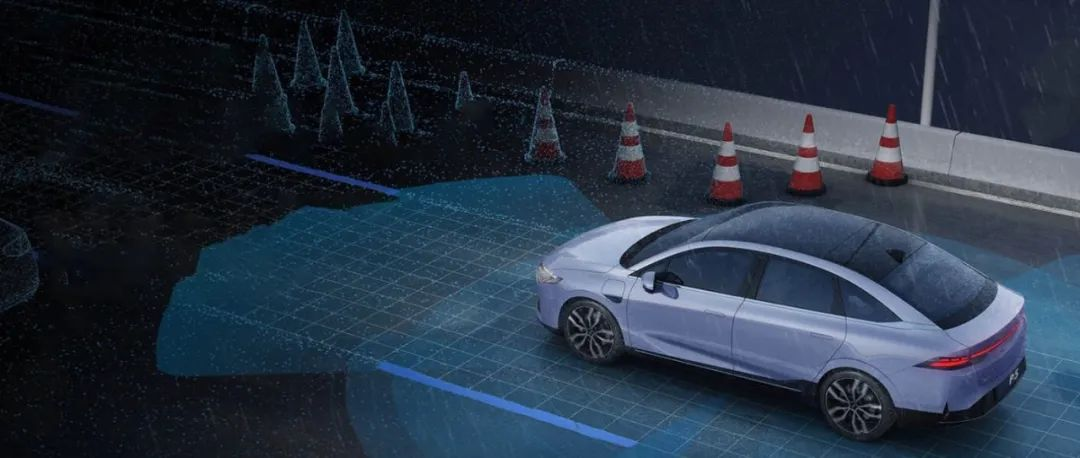Author: Tian Xi
Deadline is not the top priority, boss’s criticism is.
Just a week after XPeng Motors CEO He XPeng personally tested the urban NGP function, the XPeng City NGP engineering version welcomed the latest iteration update on July 4th.

From the video released by the official, this test had a longer road distance, covering a total of 26 kilometers from XPeng’s headquarters in Guangzhou to the Guangzhou Tower. The route was more diverse and the scenarios included passing through traffic lights, curves, tunnels, bridges, roundabouts, construction zones, and more. In addition, it involved operations such as turning at intersections, switching between main and auxiliary roads, merging, and U-turns.
From the final performance, the XPeng City NGP test went without any intervention throughout, effectively coping with the complex road conditions in real driving scenarios. Additionally, the XPeng City NGP took a total time of 46 minutes, very close to the average urban driving speed.
After watching the test video, many netizens exclaimed that it was “close to the level of an average driver”. Even He XPeng, who personally test drove it in the previous round, exasperatingly remarked that it was “as difficult as being an employer”. He finally expressed satisfaction this time and posted, “I am especially happy” about the successful performance in the “hard mode”.
What improvements and new features did the latest version of the XPeng City NGP make? Let’s find the answers together from the following video.
XPeng City NGP’s Return to Guangzhou’s CBD, Traveling 26 Kilometers Without Any Intervention
Compared with the test on June 27, XPeng City NGP had made significant improvements in handling large vehicles and merging. For instance, if there was a slow-moving bus in front, the XPeng City NGP would quickly recognize it and then overtake the bus by changing the lane, or would slow down in advance and avoid when encountering vehicles merging or changing lanes to the right.

In the past, when facing large vehicles like buses, XPeng City NGP’s overall strategy tended to be conservative, especially when facing the situation of buses cutting in from the right lane, where the car would come to a full stop, posing a risk of rear-end collision. He XPeng criticized this strategy as “seems like IQ has declined by a generation”.
Now, after version iteration, XPeng City NGP has greatly improved its driving efficiency.
The other major change in XPeng City NGP is the addition of more diverse driving scenarios.The first challenge that the XPeng Motors faced during its journey from its headquarters in Guangzhou was an oncoming electric scooter traveling in the wrong direction. As shown in the video, the XPeng NGP reacted quickly, made an emergency brake and avoided the scooter, ensuring the safety of the vehicle.

Approaching Guangzhou CBD, XPeng Motors encountered another dangerous situation – a delivery electric bike merging into the same lane from the right. XPeng City NGP detected and preemptively slowed down to avoid a collision.

Encountering non-motorized vehicles traveling in the wrong direction or motorized bikes abruptly merging into their lane are common occurrences for human drivers. If autonomous driving technology can not respond as swiftly and flexibly as human drivers, its mass implementation will be difficult. Based on the performance of XPeng City NGP, the answer is a resounding “yes”.
Navigating around construction sites is another crucial test of autonomous driving’s capabilities. Roads in cities are often temporarily closed during construction, and if autonomous vehicles rely solely on high precision maps, they can drive straight into a dangerous zone. During the Guangzhou test run, XPeng City NGP demonstrated how to safely respond to such scenarios.

The XPeng City NGP display showed that a construction zone was identified ahead on the right, and XPeng City NGP took action accordingly, switching to the left lane twice in a row to avoid the obstacle, and preventing congestion caused by lane reductions and traffic flow.
Passing through the tunnel was the highlight of the XPeng City NGP’s test drive. This is a crucial test that all autonomous driving companies must face.
Currently, autonomous driving technology is mainly divided into pure visual and multi-sensor fusion solutions. However, whether one or the other is used, cameras will be used, and when the vehicle exits the tunnel, there will be a strong light effect, causing temporary blindness for both human eyes and cameras, which poses a significant safety hazard if autonomous driving solely depends on cameras.
This is where LIDAR comes into play. Due to its working principle of using self-emitted light beams to detect and map obstacles, it is immune to the effects of strong light.
 From the video, it can be seen that at the moment the car was about to emerge from the tunnel, there was a blank space in front of it. In normal situations, human drivers usually slow down in advance to ensure safety. However, due to the two LiDARs mounted on the small Xpeng P5, the car was able to smoothly drive out of the tunnel at a constant speed, which is where autonomous driving surpasses human driving.
From the video, it can be seen that at the moment the car was about to emerge from the tunnel, there was a blank space in front of it. In normal situations, human drivers usually slow down in advance to ensure safety. However, due to the two LiDARs mounted on the small Xpeng P5, the car was able to smoothly drive out of the tunnel at a constant speed, which is where autonomous driving surpasses human driving.

In the official video released, the small Xpeng NGP also demonstrated other functions, such as passing through misaligned intersections, multi-layer road networks, and complicated roundabouts, smoothly switching and passing through complex traffic lights and left and right turns, continuous bends, and eventually successfully reaching the destination.

In the whole process of 26 kilometers, the small Xpeng P5 passed 34 traffic lights, turned at 14 intersections (including 4 unprotected left turns), switched between main and auxiliary roads 10 times, passed through 6 bends, 5 tunnels, 4 merges, 2 bridges (Guangzhou Bridge, Liede Bridge), 2 misaligned lane line intersections, made 1 U-turn, passed through 1 roundabout, and 1 construction zone, taking a total of 46 minutes.
Converted into speed, it is close to 35 kilometers per hour, and because it was tested in the traffic-intense Guangzhou downtown, the performance of small Xpeng NGP is already very impressive.
What is even more praised is its traffic efficiency. Previously, the delay issue caused by overly cautious behavior and the speed-up delay after a full stop, which were crazily dissed by He XPeng, have now been addressed to some extent in the new version of small Xpeng NGP.

According to He XPeng’s disclosure on Weibo, the new version of small Xpeng NGP optimized the efficiency factor for the first time among the important factors of safety, scenario, experience, and efficiency, achieving over 90% efficiency in scenario-based traffic flow, approaching the navigation time.
Therefore, it can be seen from the testing process that the overall experience of small Xpeng NGP is very smooth, and the car achieved “0 handover” completely. The official even asked proudly, “Is it really that smooth?”
Currently, small Xpeng NGP is still being continuously iterated, with a update cycle of ‘weekly’, and according to the news revealed in the Xpeng Automotive’s Q1 financial report, small Xpeng NGP may be launched at the end of the second quarter of this year.
Of course, this depends on obtaining regulatory approval.
Xpeng’s Autonomous Driving Assistance Will Be Launched Next Year, and L4 Has Also Been Put on the Agenda.Compared to highways, the difficulty of intelligent navigation assisted driving on city roads is several orders of magnitude higher. As seen in the NGP testing video in XPeng City, the mix of pedestrian and vehicle traffic as well as sudden road conditions create great uncertainty in the safety of promoting this technology.
Currently, the mainstream technology path of domestic autonomous driving companies is still to integrate multiple sensors. He XPeng recently stated in an interview with the “程邀” column that this is in line with the current national conditions and city road characteristics of China, but it does not mean that it is the final stage of autonomous driving.
In his opinion, the pure visual solution represented by Tesla, although difficult to implement in the short term, even in several years, is highly imaginative over the long term.
And this is also the direction that XPeng Motors is striving for. “We use high-precision maps, but the dependence is weak. We are also not willing to heavily rely on LiDAR. But if we only rely on cameras and do not have redundant backups, we cannot achieve safety in complex traffic environments, so it is a balanced logic.”
However, He XPeng is convinced that this kind of solution will become simpler as time goes on, and the NGP function of XPeng City will soon be compatible with cars without high-precision maps.
On the other hand, XPeng is keeping a gradual pace in promoting the NGP function in cities. According to He XPeng’s plan, he hopes to gain applications in several cities one by one in the early stage. Perhaps after accumulating a certain number of scenes, the process will be accelerated.
“We will first move from one city to another, and then maybe we will accelerate to five cities at the same time when we reach the fifth or tenth city. By the time we reach the 100th city, it may have been fully implemented.”
This approach is in line with He XPeng’s four evaluation dimensions of autonomous driving technology: not only to consider the overall effectiveness, cost, and safety factors, but also to expand the scope of autonomous driving, not just limited to small areas.
“In terms of the comprehensive four factors, Tesla has achieved the best balance, even we admit it today. However, next year XPeng hopes to be the number one in the four combinations.”
From the existing information, this heavy responsibility seems to fall on the XPeng G9. Compared with the XPeng P5, the XPeng G9 has further hardware upgrades, equipped with not only two LiDARs, but also two NVIDIA OrinX chips.
In the “程邀” interview, He XPeng openly praised the XPeng G9 as his favorite, and stated that the CNGP on the XPeng G9 will be smarter, and can achieve point-to-point full-scene automatic assisted driving.
According to the time plan, the automatic driving function of XPeng Motors will be launched next year, and the more advanced L4 is also on He XPeng’s agenda – 2026.
This progress even surprised He XPeng himself. “I used to think that L4 would be impossible to achieve before 2030, because the people who wanted to achieve it were all software writers who had never made cars.”But now, He XPeng’s attitude has changed. According to his observation, there has been a visible leap forward in the smart car market since 2021. On the one hand, the high cost of travel due to continuous rise of oil prices has prompted many owners of fuel cars to turn their attention to electric cars. On the other hand, with the innovative progress in battery technology, the anxiety of electric car mileage has been significantly alleviated, leading to more people trying them out who were previously watching from the sidelines.
Reflected in the data, 3.312 million new energy passenger cars were wholesaled in 2021, a year-on-year increase of 181.0%; and the retail sales reached 2.989 million, a year-on-year increase of 169.1%. As for traditional fuel cars, the wholesales were 17.79 million in 2021, a year-on-year decrease of 4%, and the retail sales were 17.16 million, a year-on-year decrease of 6%.
He XPeng judged that from the third quarter of 2023, intelligent cars would have an accelerated iterative process, and by the end of 2023, they would welcome a real dawn. “We have been waiting for this time. Starting from the second half of next year, Xpeng Motors will have a considerable number of interesting products coming out, such as flying cars…”
Back to the present, He XPeng remains pragmatic. “The Xpeng G3 has achieved the ultimate in automatic parking, and the Xpeng P7 has achieved very good data in China for NGP. We hope that the Xpeng P5 can do a good job with city NGP after approval.”
In 2022, city autonomous driving will face a fierce battle
If nothing unexpected happens, Xpeng Motors’ CNGP will become the domestic first mass-produced urban intelligent assisted driving system. At the same time, Ideal, NIO and other self-developed new forces of automatic driving technology are also accelerating to install this function.
Autohome.com has learned that NIO ET7 has realized mass production of ACC (Adaptive Cruise Control) and LCC (Lane Centering Control) functions. With subsequent software iteration and upgrade, NOP+ (Enhanced Navigation Pilot Assistant Driving Ability) based on LIDAR technology will start delivery in the third quarter of this year.
Ideal launched its self-developed high-speed NOA function at the end of 2021, which is expected to achieve urban NOA between 2023 and 2024, and urban FSD (Fully Autonomous Driving) in 2025.
Internet technology giants represented by Huawei, Baidu, and DJI have also plunged into the “arms race” of automatic driving technology and seek to cooperate with automakers to achieve commercial mass production.
Huawei previously revealed that the ADS advanced autonomous driving system will be first commercially used on the Fox Alpha S·HI version, and has the ability of full-scenario autonomous driving in high speed, urban areas and parking.
In December 2021, Baidu announced the launch of the ANP city navigation assisted driving program based on Apollo Lite. The cooperative clients of this program currently include WM Motor, Jidu, Great Wall, Landtu, BYD, etc.Robotaxi, with a focus on urban road scenes, is also making strong efforts.
For example, WeRide has formed a strategic partnership with Bosch, officially entering the development and application of L2-L3 level solutions;
In addition, PlusAI has released the forward-facing L4 level autonomous driving solution “DeepRoute-Driver 2.0,” with a cost as low as $10,000;
Also at the brand event, L4-level autonomous driving solution DBQ V4 was announced by QCraft, with a cost as low as 10,000 RMB…
The most eye-catching of all, Momenta’s L2-level production-grade autonomous driving Mpilot has established deep cooperation with IM Auto and Shaolin Zhixing, providing the latter with high-level advanced driver assistance solutions.
Furthermore, Momenta, in conjunction with BYD Auto and Lotus Cars, has established autonomous driving companies to jointly develop vehicle models.
At present, XPeng Motors is undoubtedly the leader in domestic mass-produced urban autonomous driving. On the other side of the ocean, Tesla is leading the development of American urban autonomous driving.
According to the latest news, Tesla FSD is accelerating its iteration and opening up to more users for testing.
On May 17 local time, Musk said at the All in Summit in Miami that there are about 100,000 car owners participating in FSD Beta testing, and by the end of 2022, the number of testers will be expanded to about 1 million. This number was only 60,000 at the end of last year.
Some car owners have already revealed that the “Driver Safety Score,” which is linked to FSD Beta push, has recently started to lower the score line. In the past, a score of 98 was required to pass, but now a score in the 70s can also pass. Some North American netizens even found that there is no longer a safety score limit to apply for FSD testing.
This change undoubtedly reflects Tesla’s strong confidence in the maturity of FSD features. Currently, version FSD 10.12 has been pushed to Tesla employees. According to some disclosed update logs, FSD 10.12 can display more detailed and realistic detail models when recognizing other vehicles, such as recognizing double brake lights and turn signals.
In addition, driving on roads without a protected left turn, without lane markings, and evasive lane changing when there are cars in front and behind are all important content of this FSD 10.12 update.
According to Musk’s previous statement, Tesla maintains a pace of one version every two weeks, and it is expected to release FSD 11 this summer to achieve L4-level autonomous driving in most cities.
This article is a translation by ChatGPT of a Chinese report from 42HOW. If you have any questions about it, please email bd@42how.com.
